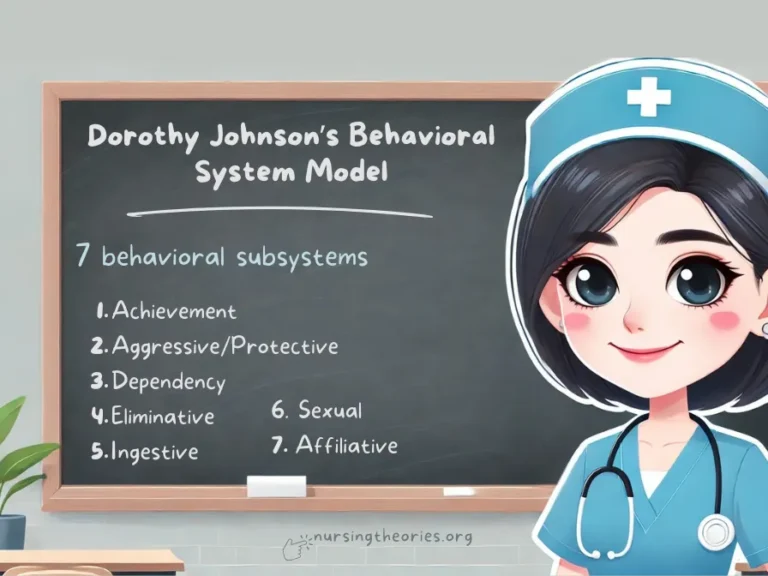Nursing theories are the backbone of the nursing profession, offering structured frameworks that guide practice, research, and education.
These theories are made up of core components that work together to explain, predict, and improve nursing care.
Understanding these components helps nurses connect theory to real-world practice, making care more effective and meaningful.
Let’s break down the components of nursing theories into manageable parts, with practical examples to illustrate their application.

What You’ve Learned
- Concepts are the foundation of nursing theories: They represent the essential ideas or phenomena in nursing, such as health, nursing care, and the person, providing the building blocks for theoretical frameworks.
- Definitions ensure clarity and consistency: Theoretical and operational definitions clarify abstract concepts and make them measurable, guiding both practice and research.
- Propositions link concepts and provide direction: These statements describe relationships between concepts, helping nurses understand how interventions influence outcomes.
- Assumptions form the theory’s foundation: Accepted truths without direct evidence, assumptions shape the lens through which nursing care is understood and practiced.
- The metaparadigm provides a universal framework: Encompassing the concepts of person, environment, health, and nursing, the metaparadigm ensures a holistic approach to nursing care across all settings.
What are the Components of Nursing Theories?
Nursing theories are structured frameworks that guide nursing practice, research, and education.
They are made up of core components that help nurses understand, explain, and improve patient care.
By understanding these components, nursing students can connect theoretical concepts to practical applications, enhancing their ability to deliver patient-centered care.
1) Concepts: The Building Blocks
What Are Concepts?
Concepts are the fundamental ideas or phenomena that make up the foundation of a nursing theory.
They help nurses understand, organize, and interpret the complexities of patient care.
Concepts can be:
- Global Concepts: Broad and overarching, such as “health,” “person,” “nursing,” and “environment.”
- Middle-Range Concepts: Focused on specific aspects of nursing, such as “comfort” or “communication.”
- Empirical Concepts: Observable and measurable, like “vital signs” or “pain level.”
Example in Practice:
In Orem’s Self-Care Deficit Theory, the concept of self-care is central.
It helps nurses assess patients’ ability to perform essential tasks, like eating or grooming, and guide interventions to meet those needs.
Think of it as…
Concepts are like the building blocks of a house; each one contributes to creating a strong, functional structure.
2) Definitions: Clarifying Meaning
What Are Definitions?
Definitions give clear meaning to concepts, making them easier to understand and apply.
They can be:
- Theoretical Definitions: Broad descriptions of what a concept means within the theory.
- Example: Health is defined as a holistic state of well-being in Newman’s Theory of Health as Expanding Consciousness.
- Operational Definitions: Practical criteria for measuring or observing concepts.
- Example: Pain can be defined operationally as a patient’s self-reported score on a pain scale from 0 to 10.
Why Are Definitions Important?
Without definitions, concepts might be misunderstood or misapplied.
Definitions ensure consistency in how theories are interpreted and implemented.
3) Propositions: Connecting the Dots
What Are Propositions?
Propositions describe the relationships between concepts.
They explain how one concept influences another, guiding nurses in understanding cause-and-effect dynamics in care.
Types of Propositions:
- Descriptive Propositions: Describe relationships (e.g., “Effective communication builds trust.”).
- Relational Propositions: Explain cause-and-effect (e.g., “Increased nurse-patient communication improves satisfaction.”).
- Prescriptive Propositions: Guide actions (e.g., “Administering medication within 30 minutes of a patient’s request will reduce pain.”).
Example in Practice:
In Peplau’s Theory of Interpersonal Relations, the proposition that “nurse-patient collaboration improves therapeutic outcomes” informs how nurses build effective relationships with patients.
4) Assumptions: Foundational Beliefs
What Are Assumptions?
Assumptions are basic beliefs or ideas that are accepted as true without direct evidence.
These beliefs provide the foundation for the theory’s framework.
Example:
In Watson’s Theory of Human Caring, one assumption is that caring relationships between nurses and patients are central to healing.
Why Are Assumptions Important?
Assumptions set the stage for how concepts and propositions are developed and applied.
They reflect the values and philosophy of nursing care.
5) The Metaparadigm of Nursing
What is the Metaparadigm of Nursing?
The metaparadigm encompasses the four broad concepts that define the nursing profession:
- Person: The recipient of care (individual, family, group, or community).
- Environment: The internal and external factors affecting health.
- Health: The level of wellness or well-being experienced by the person.
- Nursing: The actions and interventions provided by nurses to promote health.
Example in Practice:
In Rogers’ Science of Unitary Human Beings, the person is seen as an energy field interacting with the environment, influencing how nurses approach holistic care.
6) Philosophy: Values, Beliefs, and Assumptions about Nursing Care
What Is Philosophy in Nursing Theories?
Philosophy reflects the theorist’s values, beliefs, and assumptions about nursing care.
It shapes how concepts, propositions, and assumptions are framed and applied.
Key Elements of Philosophy:
- Values: Core principles like compassion, empathy, and respect.
- Beliefs: Ideas about health, nursing, and the patient’s role in care.
- Assumptions: Foundational ideas about the nurse-patient relationship.
Example in Practice:
In Watson’s Theory of Human Caring, the belief that caring is a universal human value influences how nurses approach their interactions with patients.
Think of it as…
Philosophy is like the mission statement of a nursing theory—it defines what the theory stands for and why it matters.
How These Components Work Together
The components of nursing theories don’t exist in isolation.
They interact to form a cohesive framework that guides nursing practice, research, and education.
For example:
- Concepts provide the foundation.
- Definitions clarify their meaning.
- Propositions link them together.
- Assumptions set the stage.
- The Metaparadigm and Philosophy offer overarching context.
Example in Practice:
In Kolcaba’s Theory of Comfort, concepts (comfort), propositions (comfort improves outcomes), and assumptions (patients benefit from holistic care) work together to guide nursing interventions.
The Nursing Metaparadigm
The nursing metaparadigm is a conceptual framework that defines the foundational elements of nursing practice.
These four broad concepts—person, environment, health, and nursing—serve as the pillars for all nursing theories.
Understanding the metaparadigm helps nurses connect theoretical principles to real-world applications, ensuring holistic and patient-centered care.
Read more about the Nursing Metaparadigm with Examples
Classification of Nursing Theories
Nursing theories can be classified based on their scope and focus, helping nurses understand how and where to apply them in practice.
These classifications include abstraction levels, goal orientation, and other criteria.
Read more about the Classification of Nursing Theories
How Components Interact in Nursing Theories
Understanding the individual components of nursing theories is important, but the real power lies in how these components interact to form a cohesive framework.
Together, they provide structure, meaning, and practical application to nursing care.
Conceptual Framework: Connecting the Pieces
Each component of a nursing theory—concepts, definitions, propositions, assumptions, and philosophy—works together to create a conceptual framework.
This framework allows nurses to analyze patient needs, predict outcomes, and design effective interventions.
Example in Practice:
In Kolcaba’s Theory of Comfort, the concepts (comfort), propositions (comfort leads to better outcomes), and assumptions (patients have holistic comfort needs) combine to guide nurses in providing tailored interventions, such as offering emotional support or ensuring physical comfort during procedures.
Think of it as…
A puzzle where each piece is essential for seeing the whole picture.
The components work together to provide a complete understanding of patient care.
Real-World Application
Nursing theories are not confined to textbooks; they come to life in everyday practice.
For example:
- Concepts guide assessment: A nurse uses the concept of “pain” to evaluate a patient’s discomfort.
- Definitions clarify actions: “Pain” is operationally defined as a score on a pain scale, guiding interventions like administering analgesics.
- Propositions link interventions and outcomes: Effective pain management improves recovery times.
This interaction ensures care is not only systematic but also patient-centered.
Reflective Question:
How might understanding these interactions change the way you assess and address patient needs?
The Role of Nursing Theories in Guiding Practice
Nursing theories provide a roadmap for delivering high-quality, evidence-based care.
They offer structured approaches that help nurses navigate complex clinical situations with confidence.
Foundation for Evidence-Based Practice
Theories give nurses a framework for making decisions rooted in research and proven methods.
They also help ensure consistency in care across different settings.
Example in Practice:
Using Watson’s Theory of Human Caring, a nurse prioritizes empathy and relational care while performing technical tasks like wound dressing.
This creates a healing environment that addresses the patient’s emotional and physical needs.
Think of it as…
A compass that keeps you aligned with best practices, even in challenging situations.
Clinical Decision-Making
Nursing theories provide tools for assessing situations, prioritizing care, and evaluating outcomes.
They help nurses make informed decisions that improve patient outcomes.
Example in Practice:
In Peplau’s Theory of Interpersonal Relations, a nurse builds trust with a patient experiencing anxiety, using communication strategies that promote cooperation and reduce distress.
Reflective Question:
How can integrating nursing theories into your practice help you feel more confident in decision-making?
The Importance of Definitions and Propositions in Nursing Theories
Definitions and propositions are essential components of nursing theories because they provide clarity and direction for practice and research.
Ensuring Clarity and Precision
Definitions help nurses understand and measure abstract concepts like “health,” “comfort,” or “pain.” They ensure that nurses have a common understanding of terms, reducing ambiguity in patient care.
Example in Practice:
In Kolcaba’s Theory of Comfort, comfort is clearly defined as the immediate experience of relief, ease, or transcendence.
This clarity allows nurses to focus their interventions and measure success effectively.
Think of it as…
Defining the rules of the game—everyone understands what’s expected, leading to better outcomes.
Facilitating Research
Propositions provide the backbone for nursing research, linking concepts and guiding studies to test relationships and predict outcomes.
Example in Research:
A study testing Orem’s Self-Care Deficit Theory might explore the proposition that “providing self-care education improves patient independence.” This research not only tests the theory but also provides evidence to refine nursing practice.
Reflective Question:
What nursing concepts in your practice could benefit from clearer definitions or stronger research evidence?
The Role of Assumptions in Nursing Theories
Assumptions form the underlying beliefs and values that shape nursing theories.
These foundational ideas are not directly tested but are accepted as truths within the context of the theory.
They provide a lens through which nurses view their practice, influencing everything from patient interactions to the design of interventions.
Underlying Beliefs and Their Impact
Assumptions reflect the theorist’s perspective on essential elements of nursing, such as the patient’s role, the nurse’s responsibilities, and the nature of health and healing.
These beliefs guide how theories are constructed and applied in practice.
Example in Practice:
In Watson’s Theory of Human Caring, a key assumption is that caring relationships between nurses and patients are central to healing.
This belief encourages nurses to prioritize empathy and presence, fostering trust and promoting emotional well-being.
Think of it as…
The foundation of a house—assumptions provide the stability upon which the rest of the theory is built.
Shaping Nursing Interventions
Assumptions also influence how nurses approach care.
They provide a framework for understanding patient needs and designing interventions that align with the values of holistic, patient-centered care.
Reflective Question:
What assumptions guide your own nursing practice, and how do they impact your patient interactions?
The Evolution and Application of the Metaparadigm
The metaparadigm—the core framework of person, environment, health, and nursing—is foundational to nursing theories.
It provides a universal language for the profession and evolves as nursing practice and societal needs change.
The Dynamic Nature of the Metaparadigm
Over time, the metaparadigm concepts have expanded to reflect new understandings of healthcare.
For instance, the concept of environment has grown to include not only physical surroundings but also social determinants of health, like economic status and access to resources.
Example in Practice:
A nurse working in community health uses the expanded definition of environment to address barriers like food insecurity or lack of transportation, ensuring that patients have the support they need to achieve wellness.
Practical Impact on Nursing Care
The metaparadigm provides a consistent framework that nurses can apply across diverse settings.
Whether in acute care, community health, or research, these concepts ensure that care remains holistic and patient-centered.
Example in Practice:
In a pediatric ward, a nurse considers the person (the child and family), the environment (hospital setting and family dynamics), health (promoting recovery and preventing complications), and nursing (providing compassionate, evidence-based care) to create a comprehensive care plan.
Think of it as…
The metaparadigm is the blueprint for nursing—it ensures all aspects of care are accounted for, no matter the context.
Conclusion
Nursing theories are powerful tools that shape the way nurses think, act, and deliver care.
By understanding the components of nursing theories—concepts, definitions, propositions, assumptions, the metaparadigm, and philosophy—nurses gain a deeper appreciation of the theoretical foundations that guide their practice.
These components do not exist in isolation.
They interact to form a cohesive framework that bridges the gap between theory and practice, ensuring that nursing care is both evidence-based and patient-centered.
From defining abstract ideas like health to designing interventions that promote comfort, nursing theories bring structure and purpose to the profession.
Final Reflective Questions:
a) How can integrating the components of nursing theories into your practice help you provide more effective, holistic care?
b) How can you use the components of nursing theories to enhance your approach to patient care today?




